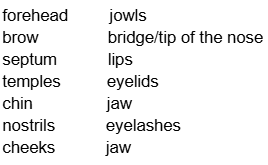Questões de Concurso
Sobre aspectos linguísticos | linguistic aspects em inglês
Foram encontradas 850 questões

(Available: https://theyuniversity.tumblr.com/post/160233605468/memespotnet.)

Consider, in the image that follows, verbal and nonverbal expression to indicate the matching item:

(Available: https://pt.slideshare.net.)
The Orality axis in the teaching of English addresses only in-person oral practices, excluding those that occur without face-to-face contact.
Regarding English grammar, judge the following item.
In English, the use of double negatives is generally
considered grammatically incorrect and non-standard in
formal writing and speech, but it is acceptable and
commonly used in some dialects and informal contexts to
emphasize a negative meaning.
Responsible state fiscal policy requires more than just balancing the current year’s budget. It must also include ensuring that the budget is on a sustainable path. Otherwise, policymakers cannot have the lasting impact they hope for. This risk is especially high in the aftermath of the COVID-19 pandemic. Record budget surpluses, driven largely by federal pandemic aid, empowered states to adopt historically large tax cuts and spending increases from 2021 to 2023.
State leaders must be able to assess whether their decisions will be affordable over the long term or will jeopardize their ability to solve state problems or even sustain programs and services in the future. Unfortunately, the nature of state budget processes discourages such long-term thinking. State policymakers devote much of their time to developing, enacting, and implementing annual or biennial budgets, a prime opportunity to achieve immediate policy goals.
One key strategy for changing this short-term focus is for states to use long-term budget assessments and budget stress tests to regularly measure risks, anticipate potential shortfalls, and identify ways to address impending challenges. Long-term budget assessments project revenue and spending several years into the future, and stress tests estimate the size of temporary budget shortfalls that would result from recessions or other economic events and gauge whether states are prepared for these events.
Internet: <https://www.pewtrusts.org> (adapted).
Considering the ideas conveyed in the previous text, as well as its linguistic aspects, judge the following item.
Without harming the meaning and the correctness of the text,
the word “ensuring” (second sentence of the text) could be
correctly replaced with to make sure.
( )Written English is more complex grammatically than spoken English, with longer and more complex sentences, fewer contractions, and more subordinate clauses.
( ) Spoken English is more likely to be face-to-face communication, while written English is more likely to be communication through the written word.
( ) Spoken English is more fixed and stable than written English, which is more fleeting.
( ) Spoken English is usually more organized and carefully formulated than written English.
( ) Written English is typically more structured and forms a monologue rather than a dialogue, while spoken English is more likely to be a dialogue.
( ) Written English communicates across time and space for as long as the medium exists and the language is understood. Spoken English is more immediate.
( ) Spoken English normally uses a generally acceptable standard variety of the language, whereas written English may sometimes be in a regional or other limited-context dialect.
( ) In Spoken English, the content is presented much more densely. In written English, the information is “diluted” and conveyed through many more words: there are a lot of repetitions, glosses, “fillers”, producing a text is noticeably longer and with more redundant passages.
( A ) GRAMMAR-TRANSLATION METHOD ( B ) DIRECT METHOD ( C ) ORAL APPROACH ( D) AUDIOLINGUALISM METHOD
( ) Grammatical rules are not presented formally and the texts used for reading and writing activities are no longer literary since this method is based on certain principles, such as: selection, gradation and presentation.
( ) Learning is associated with syntactic, morphological and phonological structures which are learned from a system of stimulus, response and reinforcement.
( ) In this method, the writing skill is also developed, but not with a communicative purpose.
( ) Adopting the monolingual principle, this method involves the use of objects, gestures and images to explain the meanings of words, since the students' native language is prohibited from being used.
( ) Language learning would be associated with the formation of readers and the intellectual development of students.
( ) This method involves automatic correction and immediate assessment of students' mistakes by teachers in order to prevent the students from forming or acquiring bad habits and behaviors during the learning process.
( ) As a theoretical systematization of foreign language teaching, its objective would be the development of students' oral skills as the vocabulary and grammatical structures they have learned would be controlled in terms of frequency of occurrence.
( ) In this method, learning must be directly connected to the target language without going through the process of translation into the students' native language.
( ) The language to be taught is the spoken language and the new elements of the language are practiced situationally as the grammatical items are proposed gradually, that is, from the simplest to the most complex forms.
( ) In this method, language is both seen and considered as a behavior, for it is a means of oral communication.
About the indefinite articles “an/a”, mark the option which it is NOT properly used
Back in October 2011, Stanford professors launched three free online courses, open to the public. One by one, these courses went massive, with enrollments topping 100.000 students each. Soon the media was calling these courses MOOCs, short for massive open online courses.
Since then, more than 1.200 universities around the world have launched free online courses. In addition to the larger global MOOC platforms, many national governments around the world have launched their own country-specific MOOC platforms, including India, Italy, Israel, Mexico and Thailand.
After a decade of popularization, in 2021, over 220 million students had signed up for at least one course on one of these platforms, and 40 million did so in 2021 alone. MOOCs and MOOC platforms are still growing, even after the crazy “Year of the MOOC” prompted by the pandemic and travel restrictions.
At Class Central, we try to catalog as many MOOCs as possible, and our listing currently includes more than 150.000 of them, from MOOC platforms and other online learning platforms. But due to limited resources, we cannot index every single one. If you’re looking for MOOCs from around the world, this list is our best attempt to catalog all different MOOC platforms that are out there.
Internet: <https://classcentral.com> (adapted).
Keeping in mind the ideas expressed above and the linguistic aspects of the text, judge the following items.
The phrase “short for massive open online courses” (in the last sentence of the first paragraph) can be correctly replaced with which stands for massive open online courses.
Read the dialogue.
A: So, I’ve decided that I’ll move to the big city to look for a dream job.
B: You know, that sounds like a good idea.
C: Well, actually you ought to make decisions about your future.
B: Right.
A: Anyway, I was wondering if either of you would help me find a furnished apartment to rent.
B: Look, I’m like...very busy during the week, I mean, I'm trying to catch up with my deadline.
C: I’m in the same boat.
A: What about the weekend? Say, Saturday afternoon? You both could take turns, and later we might grab some beers.
B: Fine with me!
C: Count me in!
The words reproducing pause, hesitation, redundancy, etc, present in the dialogue in abbreviated or full form are:
Analyse the sentences to indicate the ones with inconsistencies.
a. I can not agree to you in this situation.
b. Adriane had been marrried to Phil for so long when he died.
c. We’re just at the time to catch the train to Liverpool.
d. Sophia invests her money in the stock market.
e. Have you ever been to Singapore, Leonard?
f. Although he is a senior citizen, he can run very fast.
g. She is not only overweight but also lazy.
h. Megan apologized to Hugh for being so rude.
i. Our neighbor was charged with assault and battery.
j. Bela is so charming and beautiful as her sister but she is not a model.
l. Since he was deeply furious I said nothing.
m. Stop peering at my e-mails, that’s not your business!
In phonology, what is the term for the phenomenon in which one sound becomes more similar to a neighboring sound, resulting in two sounds becoming more alike, such as altering the pronunciation of "handbag" to "hambag" due to the influence of adjacent sounds?